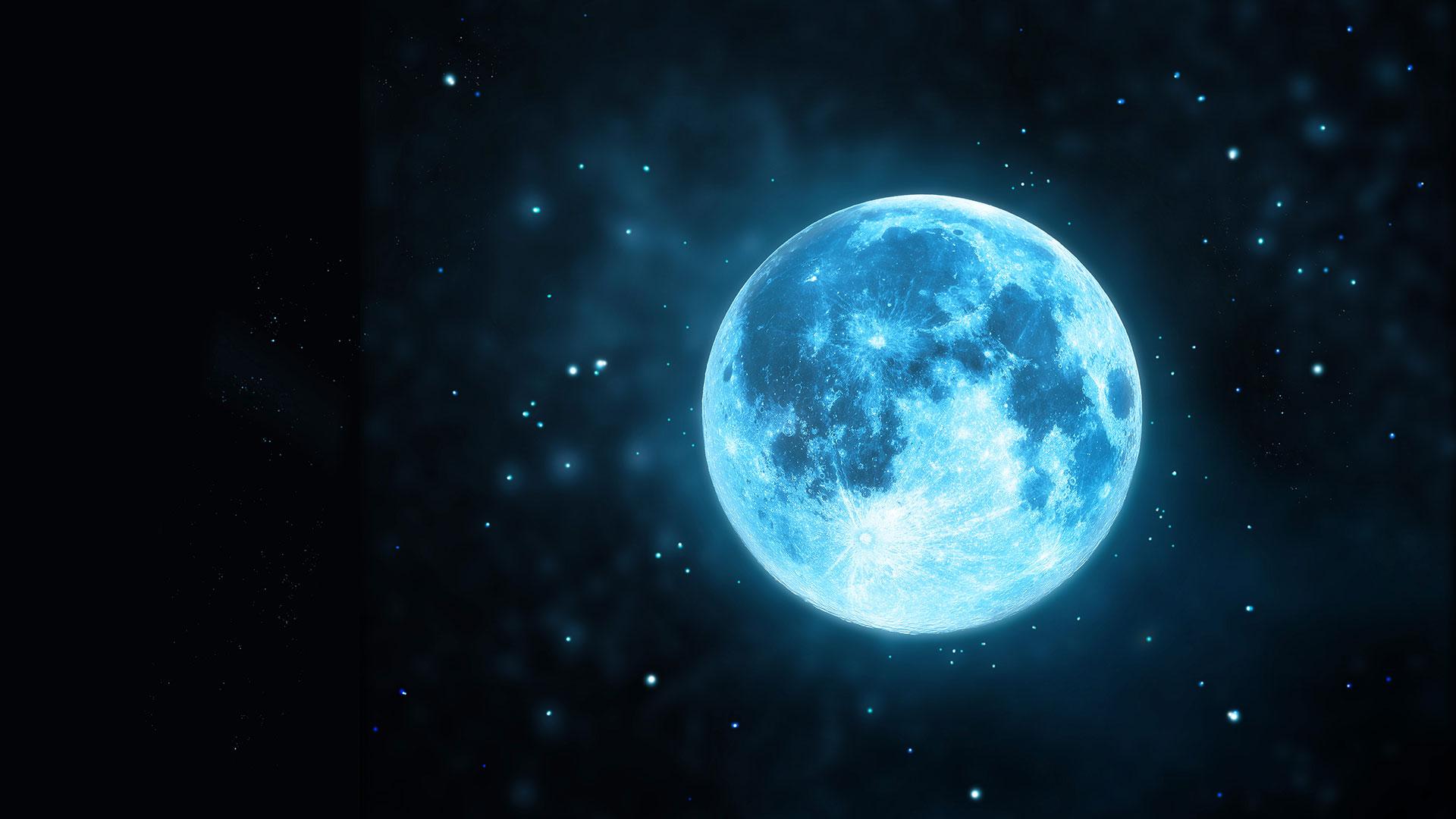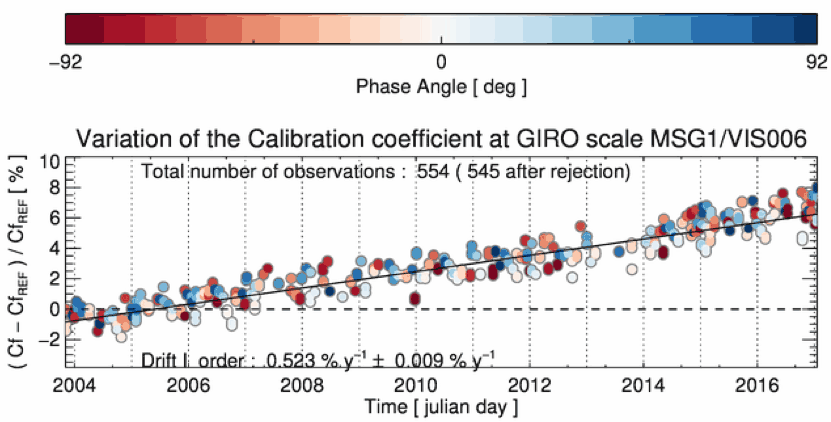30 January 2023
07 June 2018
Earth pseudo-invariant targets like desert sites, oceans, clouds or snow areas are commonly used to monitor instrument drift for reflective solar bands. By definition such targets should be stable in time and uniform in space so that the temporal variations in the signal measured by a particular instrument over such targets result from the degradation of the sensor and not from a change in the target properties.
To overcome the limitation of Earth targets, the Moon can be employed as a complementary target for drift monitoring (Stone, 2008). The Moon is a target whose properties are exceptionally stable in time (under one part per 108 per year). However, the Moon surface reflectance is not homogeneous and is not Lambertian. Consequently, comparisons between a calibration reference and the monitored instrument should be performed using the total irradiance of the lunar disc. Because coincident observations of the Moon cannot be achieved between instruments in space the only alternative is to infer a model that can estimate the lunar irradiance for a specific geometry and time and use it as a reference. The temporal stability of the Moon surface properties makes such a model valid regardless of the time of the observation.
Objectives
Lunar calibration has become a key component of the calibration tools implemented by satellite operators to monitor the drift of their instruments. Both GSICS and CEOS/WGCV recommend lunar calibration as a calibration and inter-calibration method for VIS/NIR bands that should be implemented for instruments that have the capability to sense the Moon.
The objectives of lunar calibrations are to:
- achieve an accurate monitoring of the instrument drift in order to correct for this degradation;
- complement results obtained from other monitoring methods such as vicarious calibration;
- derive inter-calibration products using common instrument references as defined by GSICS to provide users with calibration corrections for their Level 2 and Level 3 processing activities;
- ultimately, achieve absolute calibration.
Overview
EUMETSAT has been developing its monitoring capabilities for reflective solar bands by implementing a fully operational lunar calibration system, whose core is the GSICS Implementation of the ROLO model (GIRO). The GIRO was developed by EUMETSAT, in close collaboration with USGS, to provide the Lunar Calibration Community with common lunar calibration reference, directly traceable to the USGS ROLO model. The GIRO has been endorsed as the established community-available reference for lunar calibration, validated against the USGS ROLO model. It was a core goal following the First Joint GSICS Lunar Calibration Workshop in December 2014, organised by EUMETSAT, in collaboration with USGS, CNES and NASA.
EUMETSAT is routinely monitoring the warm channels of the SEVIRI instrument on Meteosat-8, -9, -10 and -11, using the GIRO (see Figure 1).
The Lunar Calibration System can also be applied to the past data from the first generation of Meteosat satellite. For example, the complete Meteosat-7 MVIRI mission was processed, generating almost 20 years of continuous lunar records. This processing relies on a robust and flexible method to extract the Moon imagery from the Level 1 data.
The results obtained with the SEVIRI data have confirmed both the usefulness of using the Moon to monitor geostationary imagers and the benefits of exploiting an extensive archive of observations that covers a broad range of illumination and libration conditions. All the SEVIRI instruments are well within specifications regarding long-term stability (see table below). The uncertainties associated with the inferred drift demonstrate that lunar calibration performed with the ROLO and GIRO models provide the most accurate estimate of the instrument degradation (of the order of 0.02% per year uncertainty for the low resolution channels and 0.05% for HRV). Similarly, it allows an efficient monitoring of the reflective solar band calibration process (vicarious calibration in the case of the MVIRI or SEVIRI instruments).
This table shows the yearly drift in % (in bold: lunar calibration; in brackets = results derived from the vicarious calibration system SSCC [SEVIRI Solar Channel Calibration system], which uses desert and ocean targets). The requirements are 2% drift per year. For Meteosat-10, the level of uncertainty is higher as the dataset is less than for the previous Meteosat.
| Satellite | VIS0.6 | VIS0.8 | NIR1.6 | HRVIS |
|---|---|---|---|---|
| Meteosat-8 | 0.503±0.010 (0.505±0.086) |
0.479±0.008 (0.521±0.072) |
0.015±0.032 (0.059±0.067) |
0.510±0.021 (0.496±0.077) |
| Meteosat-9 | 0.544±0.013 (0.403±0.125) |
0.511±0.010 (0.546±0.109) |
0.123±0.041 (0.045±0.104) |
0.503±0.038 (0.492±0.113) |
| Meteosat-10 | 0.929±0.083 (0.591±0.473) |
0.749±0.083 (0.593±0.391) |
0.594±0.366 (0.168±0.366) |
1.233±0.253 (0.580±0.419) |
Future challenges include fixing the GIRO calibration to an absolute scale and improving the existing calibration reference (the ROLO), which translates into future updates of the GIRO.
The availability of extensive Moon observation datasets will help to further improve this reference and is expected to grow with the availability of additional lunar observations from past, current and future missions.
EUMETSAT is currently centralising a community effort to constitute a GSICS Lunar Observation Dataset (GLOD) that gathers lunar irradiance data from the agencies participating in the GSICS activities. Upon the signature of a license agreement with EUMETSAT, those agencies who contribute to the GLOD have access to the latest version of the GIRO source code. The GLOD was initiated at the First Joint GSICS/IVOS Lunar Calibration Workshop. At that time, it represented potentially more than 25 instruments capable of observing the Moon, with a total spectral range extending from about 0.4 μm to 2.3 μm. Figure 2 illustrates the large variety of scanning mechanisms and acquisition configurations that adds to the difficulty of identifying potential deficiencies in the image processing and the lunar data preparation.
Lunar calibration has become an important asset of the calibration and monitoring capabilities within EUMETSAT. More recently, support to future programs such as MTG/FCI and EPS-SG/METimage has been provided by assessing the availability of lunar observations and the feasibility of performing lunar calibration with the required accuracy. This support will continue.




